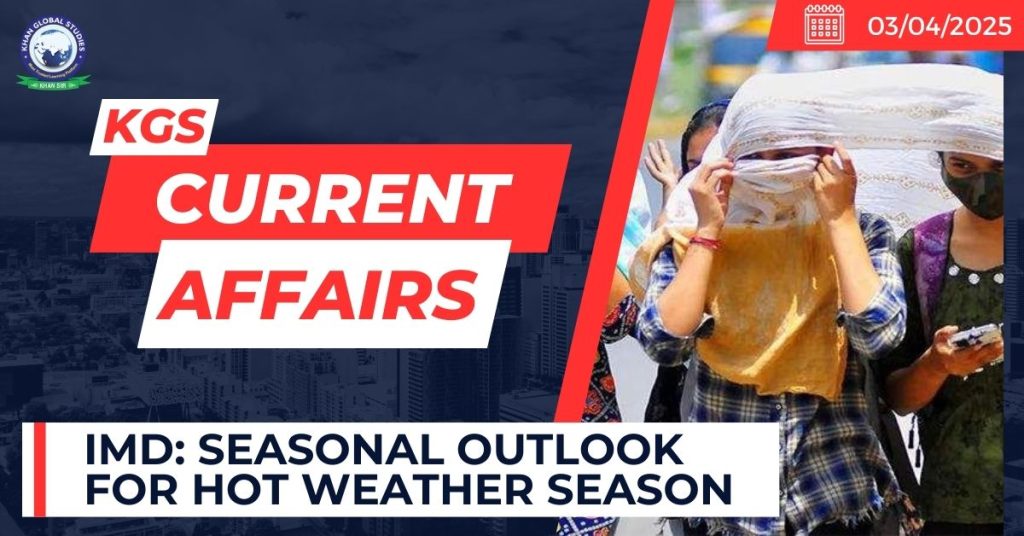Context:
India Meteorological Department (IMD)’s seasonal outlook has ruled out the possibility of El Nino during the upcoming southwest monsoon season, with forecasts indicating neutral conditions instead.
Key Highlights

The IMD has been issuing seasonal outlooks for hot and cold weather seasons since 2016, providing temperature forecasts for the country.
The IMD has ruled out the possibility of an El Nino during the 2025 southwest monsoon season.
- El Nino in 2023 led to a 6% rainfall deficit during the monsoon season, while 2024 saw an 8% surplus due to neutral conditions.
Neutral conditions imply no significant temperature rise (0.5 to 1 degree) in the central Pacific, although there have been instances when these conditions still resulted in below-normal rainfall in India.
Above-normal temperatures are expected across India from April to June, with heatwaves likely in many regions.
On average, India experiences 4 to 7 heatwave days during the summer (temperatures exceeding 45°C or a 5°C rise from normal). However, eastern India could face up to 10 heatwave days this year.
Above-normal heatwave days are expected over:
- Most parts of north and east peninsular India.
- Central India, east India, and the plains of northwest India.
April 2025 is forecasted to see an above-normal number of heatwave days in east and central India, particularly in regions adjoining peninsular India.
About the El Nino Southern Oscillation (ENSO)
- It is a climate phenomenon that affects sea temperatures in the central and eastern tropical Pacific Ocean.
- ENSO influences, alters, and interferes with global atmospheric circulation, which in turn affects global weather patterns.
- ENSO has three phases: warm (El Nino), cool (La Nina), and neutral, occurring in unpredictable cycles of two to seven years.
Normal Year (Neutral Phase):
- In a typical year with neutral ENSO conditions, the trade winds (which blow from east to west at low altitudes) push warm surface waters towards the western Pacific Ocean (near Indonesia and the Philippines).
- This displacement causes cooler waters from below to rise in the eastern Pacific Ocean (near South America), creating a temperature gradient between the east and west.
- The warm waters near Indonesia form a low-pressure zone, leading to rising air, cloud formation, and heavy rainfall, which helps build up the monsoon system over India.
El Nino (Warming Phase):
- El Nino is defined as above-average sea surface temperatures (SST) in the central and eastern tropical Pacific Ocean.
- The term El Nino, which means “little boy” in Spanish, refers specifically to the “warm phase” of the El Nino Southern Oscillation (ENSO), a broader climate pattern.
- The most recent La Niña occurred in 2020-2023, followed by an El Niño in 2023-24
- During El Nino, the trade winds weaken, reducing the ability to push warm waters towards the western Pacific.
- As a result, warm waters accumulate in the eastern Pacific Ocean near Ecuador and Peru, causing a backflow of warm water towards the South American coast.
- This disruption affects the air circulation system, weakening the Indian monsoon, and leading to reduced rainfall in India.
La Nina (Cooling Phase):

- The opposite of El Niño is La Nina (“little girl”), which is the “cool phase” marked by unusual cooling of the Pacific Ocean’s surface waters.
- La Nina is defined as cooling of the ocean surface, or below-average sea surface temperatures (SST), in the central and eastern tropical Pacific Ocean.
- In La Nina, the trade winds strengthen, pushing even more warm water towards the western Pacific, making the eastern Pacific cooler than normal.
- This results in increased rainfall in regions like Indonesia and India, strengthening the monsoon.

